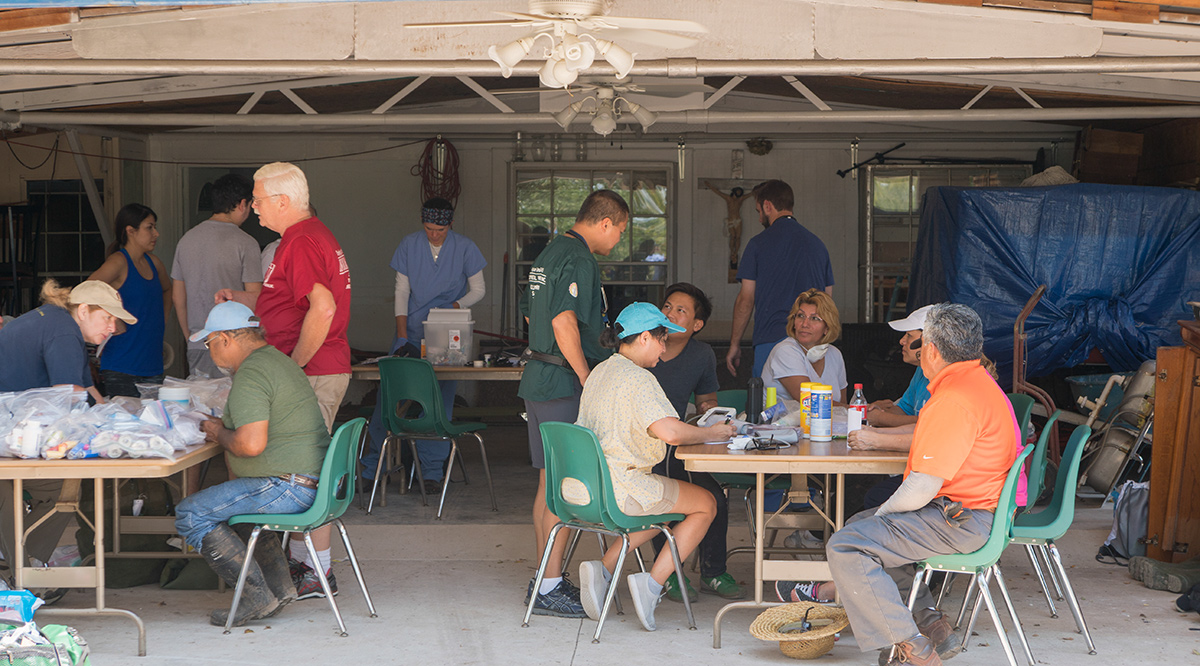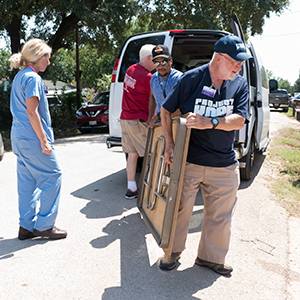
Editor’s note: This article is part of a series on climate change and health. Other articles in this series include stories on how extreme heat affects health, efforts to reduce greenhouse gas emissions in hospital cafeterias, and the impacts of extreme weather on rural and coastal communities.
In Dare County, North Carolina, which encompasses the Outer Banks beaches on the Atlantic coast, extreme weather has become almost routine in recent years.
“We’ve seen a shift in our climate over the past 10 years where we are having the extremes: extreme heat, extreme cold, snow here at the beach, things that have never happened before,” says Alex Hodges, DNP, MSN, FNP-C, a clinical professor at East Carolina University in Greenville. “Our flood zones are expanding. If you ask old timers — people born here [who are] now in their 80s — they say it’s now flooding where it’s never flooded before. … I moved here in 1993, and where we used to go to the beach is no more. It’s in the ocean now.”
In addition to the increasing heat, cold, and flooding, islanders also must cope with poor air quality from wildfires and hazardous winds from nor’easter storms. With flooding also comes the risk of infectious disease and mold-induced respiratory illness.
These now-routine extremes have the greatest impact on the county residents who struggle to afford and access health care, many of whom are patients where Hodges volunteers at the Community Care Clinic of Dare, a primary care clinic that serves underinsured and uninsured residents.
Many of the clinic’s patients work in jobs that expose them to the elements or make it difficult for them to take precautions. Many of them also have chronic conditions that are exacerbated by the challenges extreme weather brings.
“We manage a lot of diabetes, hypertension, chronic obstructive pulmonary disease,” Hodges says.
The closest Level 1 trauma medical center is 70 miles away, making disease management and prevention more important.
As climate change fuels more frequent extreme weather events across the country — from deadly fires in Maui, Hawai’i to flooding in Vermont and Pennsylvania — those who already struggle to access health care face even more health challenges. And while many turn to emergency departments at urban health systems in times of crisis, hundreds of frontline clinics that serve the medically and economically vulnerable — like the Community Care Clinic of Dare — play an increasingly important role in preventing a crisis before it gets to an acute level.
That’s why researchers at Harvard T.H. Chan School of Public Health Center for Climate, Health, and the Global Environment (C-CHANGE) in Boston partnered with Americares, a disaster relief organization, to create the Climate Resilience for Frontline Clinics toolkit, a collection of free, evidence-based resources to help prepare clinic administrators, health care providers, and patients to mitigate the negative health impacts of extreme weather.
“During these extreme weather events, attention is often on images of destruction and on the people who’ve been injured, but there’s increasing evidence that substantial health impacts can continue for days, weeks, or months afterward,” says Caleb Dresser, MD, MPH, director of health care solutions at C-CHANGE. Health problems can be exacerbated by lack of “access to normal medical care and societal infrastructure like clean water and electricity.”
“We need to be focusing beyond the acute care setting because that’s where people spend most of their time,” he adds. “[Frontline clinics] ensure continuity of care, refill prescriptions, make sure patients make their dialysis [appointments]. The more we can succeed at keeping people healthy, the more we can avoid them needing to seek emergency care” during — and as a result of — times of extreme weather.
A need for resources
In its 100 years serving uninsured people in the greater Houston area, the San José Clinic has weathered more than its share of hurricanes. Still, the clinic’s staff was not prepared for the impact of Hurricane Harvey, a Category 4 storm that inundated Houston and the surrounding areas in 2017.
“As prepared as we thought we were, we were nowhere near where we should have been,” says Adlia Ebeid, PharmD, chief clinical officer at the San José Clinic, which is a ministry of the Catholic Archdiocese of Galveston-Houston and serves more than 3,000 patients annually.
In the aftermath of Harvey, clinic volunteers went out into underserved communities — like the rural, Hispanic-majority town of Rosenberg 30 miles outside of Houston, where some families were living in flood-ravaged homes for weeks — to hand out inhalers and administer tetanus shots. Clinic staff and volunteers worked alongside teams from Americares, which was responding to the crisis by sending medical supplies and medications and providing training in disaster preparedness and mental health.

Because of the partnership built during the Hurricane Harvey response, the San José Clinic was one of the first frontline clinics to join the pilot project led by Harvard C-CHANGE and Americares to build and roll out the resilience toolkit. The researchers put together focus groups made up of providers, administrators, care coordinators, and social workers at the San José Clinic, Community Care Clinic of Dare, and seven other free and charitable clinics in four states. They also surveyed more than 450 clinic staff members in 47 states to identify the knowledge gaps and challenges that frontline clinics were facing when it came to extreme weather.
The survey findings showed that 81% of clinic staff said their clinics had experienced some disruption due to extreme weather in the past three years —but that just 20% of staff felt their clinic was “very resilient” in the face of extreme weather.
“We learned that climate-change-driven extreme weather events are really driving impacts, not only to patients but also to clinic operations,” says Nathaniel Matthews-Trigg, associate director of climate and disaster resilience at Americares. “The pilot really helped us build out the materials from having close conversations” with clinic staff to discover “what exactly is needed,” he explains.
The Harvard C-CHANGE researchers then set out to create a toolkit that filled in those knowledge gaps. The toolkit now has dozens of targeted information packets that range from checklists for clinic administrators to prepare for an imminent hurricane to handouts to help patients with asthma cope with extreme heat.
“The toolkit has been just a phenomenal item in our arsenal, so to speak,” says Hodges. “I’m bringing those toolkits into almost every [patient] visit in some way, shape, or form.”
The resources for coping with extreme heat have been particularly useful, she adds, since some of her patients have jobs that require them to work outside even when they have a chronic disease that’s exacerbated by high temperatures, like diabetes. She can give these patients a handout that provides numbered tips for managing their diabetes in the heat, including a color chart to help judge their hydration status by their urine color and an infographic showing the symptoms of heat exhaustion and heat stroke.
Ebeid has also found these resources helpful, especially since they are available in both English and Spanish.
“We know this information was researched and vetted,” she says. “We can print it and hand it over rather than having to create it and adapt it each time. With us having a very lean operation, it has been life changing.”
Furthering research and education on the impact of weather
While there is a plethora of research suggesting that climate-change-fueled extreme weather is growing more detrimental to human health, there is still a dearth of research on how it impacts health care access, particularly for socially vulnerable people, says Daniel Samano, MD, MPH, a first-year neurology resident at the University of Miami Health System and climate and public health researcher.
Samano completed medical school in his native Mexico and practiced as a physician in several different countries before his experience working in a low-income community influenced his decision to pursue two master’s degrees: in public health and in climate and health.
“I realized that being a physician went beyond caring for one patient at a time,” he says. “I decided to pursue public health so I could have better tools to help different communities, such as understanding health policy, community-based research, and much more.”
During his time earning a master’s in public health at the University of Miami Miller School of Medicine, Samano was working alongside a medical resident who was scheduled to work a shift at a clinic for people infected with HIV. The medical resident told Samano that he was going to be able to go home early that day because it was raining. People wouldn’t show up for their appointments.
The exchange inspired Samano to lead a team of researchers to examine how weather in Miami correlated with people missing appointments at the HIV clinic. They found that patients were more likely to miss an appointment on days when the temperature was over 90 degrees and on days when the precipitation exceeded one inch.
“We are now living in a world that is dealing with the impacts of climate change — impacts that are going to get worse over the course of our careers. It’s important that medical students, nurses, [and] physician assistants understand these hazards and understand steps they can take to address them.”
Caleb Dresser, MD, MPH, director of health care solutions at the Harvard T.H. Chan School of Public Health Center for Climate, Health, and the Global Environment (C-CHANGE)
Samano chose to focus on the HIV clinic because of the implications for public health when patients miss their appointments — and risk spreading the virus to other people in the community.
“Miami has [one of the] highest HIV transmission rates in the nation,” Samano says. “That’s why it is important to understand how we are interpreting these values.”
The study was a starting point, but stopped short of digging into the reasons for the no-shows or seeking ways to mitigate disruptions. More exploratory research is needed to understand why there are differences among racial and ethnic groups and to characterize the barriers that individuals and communities face during weather events, Samano says.
“Maybe they live in a neighborhood that gets flooded,” he says. “Some racial and ethnic groups come more on hot days — maybe they don’t have air conditioning at home. These are just hypotheses; we need to prove it so we can individualize interventions to care for these groups.”
Because he is passionate about how weather directly and indirectly affects health and health care access, Samano says he initially sought out resources at the Centers for Disease Control and Prevention and the National Oceanic and Atmospheric Association to learn more and conduct research in this field of study. He hopes to further develop transdisciplinary collaborations and expand opportunities for climate and health education for medical trainees and clinicians, as well as for the public.
“There is much to be done in this arena. We need to improve on behaviors, education materials, and interventions and many levels in the community,” Samano says.
Though 55% of U.S. medical schools require some education on climate change’s effect on health — and some institutions, like Harvard Medical School, George Washington University, and Emory University, are integrating climate change as a priority in the curriculum — there’s still a long way to go in preparing clinicians for the present and future impacts of climate on health care.
“We are now living in a world that is dealing with the impacts of climate change — impacts that are going to get worse over the course of our careers,” says Dresser, from Harvard C-CHANGE. “It’s important that medical students, nurses, [and] physician assistants understand these hazards and understand steps they can take to address them.”
And while climate change and extreme weather will affect health care systems at every level, community clinics for the underserved are at the front lines.
That’s why Hodges encourages researchers and trainees to get out into the field and see firsthand the realities of those challenges faced by underserved communities.
“If they have a better understanding of what it’s like to work in a rural [or underserved] area … they’ll have a better understanding of patients,” Hodges says. “It’s about the patients first. … What can we do to improve quality of life for our patients?”
